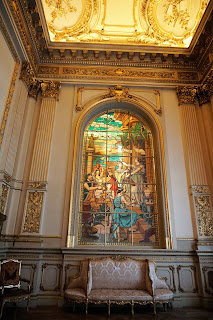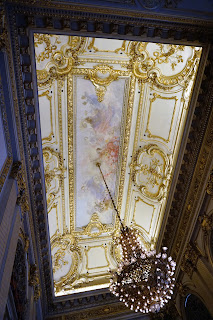Buenos Aires to Rio / Tango to Samba nights
Some of our ballroom friends who succumbed to the 'dark side' now almost exclusively dance the Argentine tango, waltzes & milongas...we have thus far remained novices as I could not in all honesty deny my partner's assertion : 'say what?! 10 dances in ballroom & latin is not enough material to keep us challenged?' ... er..yes, but a trip to the cultural milieu of the steamy sultry streets where it all came together during La Belle Epoque, buoyed each night by the Crystal Serenity culinary fare & amenities was the icing on the cake for a 'lets embark' again!!
Residing in a restored historic tenement house 'conventillo' in the oldest neighborhood of Buenos Aires ...we enjoyed passionate tango performances. How the dancers are able to executive their twists and kicks with such machismo and flair added with a dash of insouciance is a thing to marvel at. The show capped off an awesome glimpse of the 'gaucho' culture on stage via a thrilling demo of 'boleadores', the hurling of leather straps with stone tips used to wrangle livestock...at which point, we were relieved not to be seated in the front rows:-o


Ay, caramba! As beginning dabblers, we avoided the milongas for fear of the 'cabeceo', and opted instead for a private lesson with Facundo on the very nextmorning @ La Ventana Studio (pre-booked directly online). Tip: this is the way to go folks, as the cruiseship excursion costing more only provided 1 pair of instructor for 8 beginner couples! Learning the body language & torso connectivity will take practice...Its been uttered, the Arg tango 'takes a lifetime-and-a-half to learn'...lol, well then, lets not waste any more time...let it begin!

Our afternoon was spent strolling the colorful streets of La Boca, the barrio that's result of Italian immigrants pouring vibrant paints over their drab tenements in the early 20thC. Street foods and cultural souvenirs lined the El Caminito where tango artists perform along the patio cafes

 Tribute to most famous son of La Boca - born and raised in the neighborhood orphanage, Benito Martin (1890-1977) was adopted by Quinquela. He worked, lived and depicted silhouettes of laboring men, smokestacks and port life, later becoming internationally recognized never forgetting his beloved roots
Tribute to most famous son of La Boca - born and raised in the neighborhood orphanage, Benito Martin (1890-1977) was adopted by Quinquela. He worked, lived and depicted silhouettes of laboring men, smokestacks and port life, later becoming internationally recognized never forgetting his beloved roots
The Teatro Colon is the main opera house in Buenos Aires, ranked third best opera house in the world by National Geopraphic...we ducked in, tour was booked, but before then time for a stroll of the broad streets A. 9 de Julio and Av Corrientes...
Its illustrious history in full display as you enter the interior of the Teatro Colon
prestigious architecturals features and exceptional acoustics rank it among rival




 theatres such as Teatro alla Scala in Milan, Paris Opera House, Vienna & Royal Opera house in London & Metropolitan Opera in NYC... unfortunately, on that day, the sound & lighting system was in full testing mode, the theatre itself was completely pitch black ...bah! bad luck & no discount were offered on ticket :(
theatres such as Teatro alla Scala in Milan, Paris Opera House, Vienna & Royal Opera house in London & Metropolitan Opera in NYC... unfortunately, on that day, the sound & lighting system was in full testing mode, the theatre itself was completely pitch black ...bah! bad luck & no discount were offered on ticket :(

 Recolata cemetery - is it a sign that the city is living off its past if one of the top attractions is the place of internment for its historical figures??
Recolata cemetery - is it a sign that the city is living off its past if one of the top attractions is the place of internment for its historical figures??There's no denying though it's a most beautiful cemetery. We found the grave of Eva Peron, made so much more famous due to musical...yet saw many of the past presidents of Argentina and famous cultural figures' tombs
back to the ship & just in time for tea ... :-)
Next day, discovering the city of Montevideo, capital of Uruguay (meaning river of colorful birds) was a spanish colony. Monte 'hill' vi '6' deo 'from east to west'

we were fortunate to meet up the guest lecturer of Crystal's enrichment program - Earl Irvine and his wife Jeanne.
Earl had a career in the Foreign Service, serving as ambassador to Swaziland and had assignments in Sao Paulo Brazil during his time in the US State Department. Earl was equally knowledgeable & conversant about the history of Uruguay as well, as we chitchatted along our tour. Further along the cruise, we attended his enrichment lecture and met up for a wonderfully engaging dinner at @ Prego
 At the Plaza Independencia - site of monument to General Jose Gervasio Artiga, Uruguay's national hero. He was a gaucho (mix of Matis indigenous race & slaves from Aftrica & Spain) Actually died in Paraguay as he went into exile after being betrayed. Ashed were brought back in 1855 and hailed as the nation's true liberator.
At the Plaza Independencia - site of monument to General Jose Gervasio Artiga, Uruguay's national hero. He was a gaucho (mix of Matis indigenous race & slaves from Aftrica & Spain) Actually died in Paraguay as he went into exile after being betrayed. Ashed were brought back in 1855 and hailed as the nation's true liberator.Pic top left is Canadian Embassy (see flag)

A flight of stairs underneath is Artigas mausoleum
Memorial to the Holocaust of the Jewish people - 120 metres long and made of pink granite with a central window looking out at the sea. A pair of railway rails are at the front of the memorial several steles are erected including one signed by Elie Wiesel. Uruguay has largest Jewish population in S. America
Curiously clinging on the banks of the wide Rio de la Plata 'silver river' where it washes out to sea, the situs of Montevideo had one writer (The Purple Land, 1885 Hudson): "I sat down on a bench beside the sea or river - for some call it one thing, some the other, and the muddied line and freshness of the water, and the uncertain words of geographers, leave one in doubt as to whether Montevideo is situated on the shores of the Atlantic, or only near the Atlantic and on the shores of a river 150 miles wide at its mouth".


Tom posing in front of the Momumento la Carreta - sculpture depicted a wagon and straining oxen, created by local sculptor Jose Belloni to honor the ox-cart drivers of the 19th Century
Our bus driver happily wanting to let

 us sample his Mate (steeped dried bitter yerba leaves w/honey served with a metal straw) & got me to pose with in front of Legislative Palace. Before we gave up Montevideo, we had to try the 'asado' ... delicious!! We plopped ourselves down in one of the stalls ...salivating at the hissing, crackling display before us. It's truely amazing the quantity of red meats being consumed at the Mercado del Puerto. Uruguay possess the world's most cattle per capital. Cows outnumber ppl roughly 3 to 1! Must be true...we are told locals eat meat 10 to 12 times a week...meatopia!!
us sample his Mate (steeped dried bitter yerba leaves w/honey served with a metal straw) & got me to pose with in front of Legislative Palace. Before we gave up Montevideo, we had to try the 'asado' ... delicious!! We plopped ourselves down in one of the stalls ...salivating at the hissing, crackling display before us. It's truely amazing the quantity of red meats being consumed at the Mercado del Puerto. Uruguay possess the world's most cattle per capital. Cows outnumber ppl roughly 3 to 1! Must be true...we are told locals eat meat 10 to 12 times a week...meatopia!!
At Punta del Este - the getaway spot for Brazilians, Argentines & Uruguayan holiday seekers. It's elongated promontory stretches out into the Atlantic with Playa Brava on the eastern shores. Due to shifting sand dunes, forest of trees from 5 continents had to be planted to stabilize the terrain.
Los Dedos / La Mano (The Hand) similar to cloud gate or bean of another city, has become the symbol of Punta del este & is the recipient of constant touristic draw due to the intriguing subject. Chilean artist Mario Irarrazabal was inspired to make this sculpture (1982 in1st annual open air modern sculpture meet) of a hand "drowning" as a warning to swimmers, as the waters can see rough waves
At Museo Ralli, built by the owner of an Israelie bank. He situated away from the city on purpose, free to the public, distance from city to force ppl to make the effort to seek out art - its a collection of modern art focuing on Latin America & the surrealist movement

New French Realism movement of 1960s is a new perceptive approach to reality. "New Realists are determined to put an end to the divide between art and life by resorting to objects that are part of daily life and depriving them from their mere object status"
Two sculpture gardens, one of which holds extensive collection of Salvador Dali's work. At left is 'Woman in Flames' said to represent Dali's quest to immortalize women in surrealism. The beautiful faceless figure symbolizes all womenhood. Her half-hidden drawers hide her secrets and feminine wiles; they contain her timeless mystery.


Nice scenic stopping point after passing La Barra or wavy bridge - it rides like a fluid roller coaster due to its type of construction called a stressed ribbon bridge. Created by Uruguayan engineer Leonel Viera - he was the first to use this method, in which the supporting cables actually pass through the bridge itself and are embedded in the concrete.
In bus en route to tour Casapueblo: Uruguay's most eccentric hotel...well that's because its really a museum and former resident of artist Carlos Paez Vilaro


The hotel designated sections for tours to gain appreciation of Carlos' life

Born in poverty, Carlos crossed the Rio Plata to Argentina at the age of 16 and found work as an artist in Buenos Aires



His paintings portrayed the drudgery of factory workers and Afro-Mediomundo culture. He gained mentorship of Pablo Piccaso. Later, in Tahiti he painted murals for Marlon Brando, acquainted with many celebrities ( Fidel Castro, Kennedy, Sophia Loren, B Bardot)
As the Crystal Serenity docked overnight here, the next day we reserved to explore the town centre on foot, sampling shops from low to high end...



 We elected not to do the long bus ride excursion in to city of Sao Paulo but joined a tour closer to beach town of Santos close to port and visited the zoobotanical park, its orchard enclave started by Julio Conceicao back in 1903. This was probably a good choice...due to recent austerity measures there were many incidences of rotational strikes which hampers
We elected not to do the long bus ride excursion in to city of Sao Paulo but joined a tour closer to beach town of Santos close to port and visited the zoobotanical park, its orchard enclave started by Julio Conceicao back in 1903. This was probably a good choice...due to recent austerity measures there were many incidences of rotational strikes which hampers visitors with many delays. Even in terms of Crystal obtaining the necessary ship clearance to permit passengers off the ship.
visitors with many delays. Even in terms of Crystal obtaining the necessary ship clearance to permit passengers off the ship.Above pic is the common marmoset (Callithrix jacchus)
Our tour also included a visit to Museu Pele opened in June 2014
Pele was on hand for the opening at age 73. His real name was Edson (misspelled after inventor Thomas Edison) Arantes do Nascimento.. Pele was a nickname stuck due to his pronunciation of his favorite local player Vasco da Gama goalkeeper Bile He rose to football stardom in Santos playing throughout 1956-1974 leading Brazil to three World Cup titles. The King of football made history with his exquisite technique 'bicycle kick'
He rose to football stardom in Santos playing throughout 1956-1974 leading Brazil to three World Cup titles. The King of football made history with his exquisite technique 'bicycle kick'
 Life size Pele hologram in the museum
Life size Pele hologram in the museum


Last stop - Santos Coffee Museum 'Bolsa Oficial de Cafe' housed in a beautiful building displaying original furniture and mural paintings depicting the history of coffee in Brazil. Still the world's largest producer of coffee but back in the 1920s, the country supplied 80% of world's coffee. Two species, arabica (70%) and robusta (30%), the latter is cheaper & more caffinated


Both beans imported from French Guiana, but originates in the forests and highlands of Ethiopia ... sadly elicited the slave trade from Africa to toil away in the tropical sun of vast coffee plantations. In 1888, Brazil was the last country in the Western world to abolish slavery. The estimate is that 4 million slave had been imported from Africa (40% of total number brought to the Americas)













































